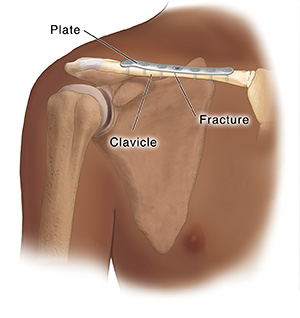Having Clavicle Fracture Open Reduction and Internal Fixation (ORIF)

ORIF is a type of treatment to fix a broken bone. It puts the pieces of a broken bone back together so they can heal. Open reduction means the bones are put back in place during a surgery. Internal fixation means that special hardware is used to hold the bone pieces together. This helps the bone heal correctly. The procedure is done by an orthopedic surgeon. This is a healthcare provider with special training in treating bone, joint, and muscle problems.
What to tell your healthcare provider
Make sure you tell your healthcare provider about all medicines you take, including over-the-counter medicines, such as aspirin. Tell them about all vitamins, herbs, and other supplements you take. Also tell your provider the last time you ate or drank. And tell your provider if you:
-
Have had any recent changes in your health, such as an illness or fever
-
Are sensitive or allergic to any medicines, latex, tape, or anesthesia (local and general)
-
Are pregnant or think you may be pregnant
Getting ready for your surgery
ORIF is sometimes done as emergency surgery after an accident or injury. Before this procedure, a healthcare provider will ask about your health history and give you a physical exam. An X-ray may be done to look at your clavicle.
In some cases, clavicle fracture ORIF is planned. You may need to stop taking some medicines, such as blood thinners and aspirin, before the surgery. If you smoke, you may need to stop before your surgery. Smoking can delay healing. Talk with your provider if you need help to stop smoking.
Also make sure to:
-
Ask a family member or friend to take you home from the hospital. You can't drive yourself.
-
Plan some changes at home to help you recover. You may need help at home after the surgery.
-
Follow any directions you’re given for not eating or drinking before the surgery.
-
Follow all other instructions from your provider.
You will be asked to sign a consent form that gives your permission to do the surgery. Read the form carefully. Ask questions if something isn't clear.
On the day of surgery
Your surgeon will explain the details of your surgery. These details will depend on where your injury is and how bad it is. An orthopedic surgeon with a team of specialized nurses will do the surgery. The preparation and surgery may take a couple of hours. In general, you can expect the following:
-
You'll likely have general anesthesia. This will prevent pain and make you sleep through the surgery. Or you may have local anesthesia to numb the area and medicine to help you relax and sleep through the surgery.
-
A provider watches your vital signs, such as your heart rate and blood pressure, during the surgery.
-
After cleaning the skin, your surgeon will make a cut (incision) through the skin and muscle around your clavicle.
-
The surgeon will put the pieces of your broken clavicle bones back into place (reduction).
-
The surgeon will secure the pieces of the broken bones to each other (fixation). They may use screws, metal plates, wires, or pins.
-
Other repairs are made to the area as needed.
-
The surgeon will close the layers of muscle and skin around your clavicle with stitches (sutures) or staples.
After your surgery
Talk with your surgeon about what you can expect after surgery. You may be able to go home the same day. Or you may need to stay in the hospital overnight. Before leaving the hospital, you'll likely have X-rays taken of your clavicle. This is to check the repair.
You'll have some pain after the surgery. Your provider will tell you what pain medicine you can take to help reduce the pain. Stay away from certain over-the-counter medicines for pain as instructed. Some of these may interfere with bone healing. You can also use ice packs to help reduce pain and swelling.
For a while after your surgery, you must be careful not to move your clavicle. This may mean you'll need to wear a sling for several weeks. Your provider will tell you when it's safe to move your arm again.
Your surgeon may also tell you to eat foods high in calcium and vitamin D to help with bone healing. You may need to take medicine called a blood thinner for a little while after your surgery. Blood thinners stop blood from clotting or clumping together. Follow all your healthcare provider’s instructions carefully.
Follow-up care
Make sure to go to all of your follow-up visits. You may need to have your stitches or staples removed a week or so after surgery.
You may have physical therapy to improve the strength and movement of your arm. The therapy may include treatments and exercises. Physical therapy improves your chances of a full recovery. Most people are able to return to their normal activities in a few months.
When to call your healthcare provider
Call your provider if you have any of the following:
-
Fever of 100.4°F (38°C) or higher or as directed by your provider
-
Chills
-
Redness, swelling, or fluid leaking from your incision that gets worse
-
Pain that gets worse
-
Loss of feeling anywhere in your body